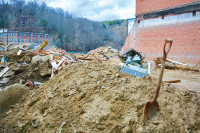Podcasting the park: “Smoky Signal” brings national park science to a new audience
 Antoine Fletcher interviews botanist Joshua Albritton for an episode about sochan. NPS photo
Antoine Fletcher interviews botanist Joshua Albritton for an episode about sochan. NPS photo
Antoine Fletcher’s love affair with podcasts blossomed back in middle school when he made his first one with his best friend. The project didn’t make them millionaires, but it was “the start of something that was really cool,” Fletcher said.
“When I think about a podcast I think about back before TVs when people used to gather around these old listening stations or these old radios, and it helped them envision what was going on in a baseball game or inauguration speech, and things like that,” he said. “And that’s the power of a podcast. The power is people using their imagination.”
Now the science communicator for the Great Smoky Mountains National Park, Fletcher is calling on the power of the podcast to bring the Smokies’ wonders to a new audience. “Smoky Signal,” a podcast about the science behind the park, debuted in March 2022 and is set to drop its third episode in the coming weeks.
“We just want to reach out to new audiences that may have lost connection with the National Park Service through just growing up where they grew up and things such as that nature,” Fletcher said. “We just want to have a fun way to reach out to them and work with them.”
Using the theme “collections,” the podcast’s first season began a year ago. In March 2022, Fletcher and his co-host at the time, ecologist Alix Pfennigwerth, each led an episode. In “Mysteries of the Museum,” Fletcher explored the park’s natural history collections, featuring an array of park partners and employees — Baird Todd, Mike Aday, Arthur Stupka, Paul Super, Becky Nichols and Janie Bitner — in his quest to find out where these collections come from and how studying decades-old specimens informs park management.
Next, Pfenningwerth investigated the importance of collecting sochan, also known as green-headed coneflower, and how this plant is helping members of the Eastern Band of Cherokee Indians renew their connection to traditional homelands in the park. The episode featured Smokies botanist Joshua Albritton and Tommy Cabe, tribal forest resource specialist for the EBCI.
Related Items
In early March, Fletcher expects to release the third and final episode in the first season, this one focused on collection of elk droppings.
“The biggest thing about this episode is showing that we have non-invasive or intrusive ways to research if these elk populations are doing well in the park,” Fletcher said. “And we can do that through the DNA that’s left behind on the fecal pellets the elk are doing.”
Since elk were reintroduced to the park in 2001, the herd has continued to grow and expand. But elk are hard to count, and for years wildlife managers struggled to accurately estimate the herd’s size. A research project expected to conclude this spring is using DNA markers from elk droppings to provide the most accurate estimate yet, along with a host of other information about the herd’s health and habits.
“We try to make our researchers at the forefront, because the Smokies is the second most-researched park in the National Park Service besides Yellowstone,” Fletcher said. “There’s so much cool research going on around everyone, and people just don’t know what’s happening.”

- The artwork for “Smoky Signal” was created by the Great Smoky Mountains Association. Donated photo
So far, “Smoky Signal” has gotten a positive reception and gathered interest far outside the Great Smokies region. While most listeners are from the Asheville and Knoxville areas, Fletcher said, many are from New York City, the Pacific Northwest and California.
“We were really surprised at the amount of listeners in places like Colorado and Seattle,” Fletcher said.
Since those initial episodes dropped, Pfenningwerth has left the Smokies for a different opportunity, and Fletcher has a new co-host. Erin Canter, manager of science literacy and research for the Great Smoky Mountains Institute at Tremont, will join Fletcher in producing a new season, expected to release this fall.
The theme, “Smokies at Night,” will allow the pair to explore the park at a time of day when few people experience it. Possible topics could include cultural stories of the park’s early inhabitants through astronomy or constellations, frog sounds and the failed red wolf reintroduction effort. They’re still narrowing it down but expect to produce two episodes this year.
Two to three episodes a year might not sound like a lot, but reporting and producing a complete, high-quality podcast takes time — especially considering the other responsibilities collaborators must satisfy in addition to the podcast.
To create an episode, Fletcher must first interview sources — which often includes driving to various sites in the park — and then spend hours making cut scenes, editing them together, adding music and sound effects, and polishing all the rough edges. Then the episode must be transcribed in order to meet NPS accessibility requirements, and finally sent around to subject matter experts for fact-checking.
“A podcast episode in a perfect world could probably take you about a month to create, but between other things that I do for work, it could take a couple of months — doing a little bit of editing, doing a little bit of music, going back and fact-checking,” he said. “An episode could easily take three months.”
Going forward, Fletcher wants to release new episodes each fall but also lean on partnerships with the park’s nonprofits and with other national parks to expand the impact of Smoky Signal. Over the next year, the Smoky Signal stream could feature episodes from podcasts produced by the park’s nonprofit partners such as the Great Smoky Mountains Association, or even from other national parks that also produce podcasts.
“The good thing about our partners is they are taking the stories from a different lens, stories that we can’t get to,” Fletcher said. “So we can make a really rich experience all working together.”









